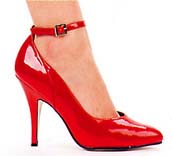[HOME - BASE Cinque - Appunti di Matematica ricreativa]
Dedicato alle donne sensuali
ovvero, qual è l'altezza ideale del tacco
delle vostre scarpe?
 |
Alcuni ricercatori dell'Institute of
Physics di Londra guidati dal Dr. Paul Stevenson hanno
ideato la formula per calcolare l'altezza del tacco
adatta a ciascuna donna.
La formula è piuttosto complessa e dobbiamo apprezzare
il settimanale GENTE che l'ha divulgata
in un simpatico articolo sul n. 25 del 17 giugno 2004 (pag
113).
La formula è comunque apparsa anche su Repubblica.it
e Focus.it.
Purtroppo, in tutti e tre i casi la formula è stata
presentata con uno o più errori che qui cerco di
correggere. |
Ma c'è molto di più: le gentili signore che
desiderano conoscere subito l'altezza ideale del tacco adatto a
loro senza avventurarsi in difficili calcoli possono farsi
aiutare dal computer.
NOTA: è necessario conoscere la propria misura di scarpe
secondo il sistema inglese. Per trovarla puoi consultare la
seguente tabella.
| Che numero di
scarpe porti? |
| Sistema inglese
(UK ladies sizes) |
2 |
2.5 |
3 |
3.5 |
4 |
4.5 |
5 |
5.5 |
6 |
6.5 |
7 |
7.5 |
8 |
| Sistema europeo |
34 |
35 |
35.5 |
36 |
37 |
37.5 |
38 |
39 |
39.5 |
40 |
40.5 |
41 |
42 |
Inserisci
i dati nello schema qui sotto e il computer
ti dirà la misura del tuo tacco ideale
Rilassati,
questo algoritmo è una ciliegina!
| Spiegazione della
formula di Paul Stevenson La formula
per calcolare l'altezza ideale del tacco è la seguente:
Altezza = Q * [12 + (3s/8)] (in
centimetri)
La s è il vostro il numero di piede
secondo il sistema inglese (consultate la tabella qui
sotto).
| Che
numero di scarpe porti? |
| Sistema
inglese (UK ladies sizes) |
2 |
2.5 |
3 |
3.5 |
4 |
4.5 |
5 |
5.5 |
6 |
6.5 |
7 |
7.5 |
8 |
| Sistema
europeo |
34 |
35 |
35.5 |
36 |
37 |
37.5 |
38 |
39 |
39.5 |
40 |
40.5 |
41 |
42 |
La Q è un fattore
sociologico compreso fra 0 e 1 definito come
segue:
Q = [p * (y + 9) * L] / [(t + 1) * (A + 1) * (y
+ 10) * (L + 20)]
ATTENZIONE!
Preciso che nella formula di Stevenson, la variabile L e
il numero 20 sono valori in sterline inglesi.
Se noi vogliamo scrivere il valore in Euro, dobbiamo
introdurre nella formula il fattore di conversione Euro-Sterlina.
A giugno 2004:
1 Euro = 0.659350 Sterlina Gran Bretagna
1 Sterlina Gran Bretagna = 1.5166 Euro
Q = [p * (y + 9) * L* 0.659]
/ [(t + 1) * (A + 1) * (y + 10) * (L* 0.659 +
20)]
Vediamo i significati delle variabili:
- La variabile p è la probabilità
che i vostri tacchi facciano girare la testa agli
uomini. E' un numero decimale compreso fra 0 e 1.
Scegliete 1 se, quando portate i tacchi, tutti
gli uomini si voltano a guardarvi con ammirazione.
Scegliete 0 se invece tutti gli uomini si voltano
dall'altra parte disgustati. Se la vostra
situazione è intermedia scegliete un altro
numero compreso fra 0 e 1.
- La y indica da quanti anni usate
scarpe con tacchi alti (per esempio 10).
Praticamente la y esprime la vostra esperienza
nell'utilizzare i tacchi. Più esperienza avete e
più potete osare.
- La L indica il costo delle
scarpe (per esempio: 100 euro = 100). Più le
avete pagate e più siete disposte a soffrire per
indossarle.
- La t indica quanto tempo è
passato in mesi da quando la scarpa era di moda.
Praticamente è l'età della scarpa. Una scarpa
fuori moda è meno interessante.
- La A indica quanti bicchieri di
vino prevedete di bere quando avrete indosso le
scarpe: 0 se non bevete, 1 per un bicchiere e così
via. L'alcool tende a far perdere il
coordinamento aumentando il rischio di cadere se
si indossano scarpe col tacco alto.
|
Per chi sa l'inglese, ecco un estratto della
versione originale tratto da: Institute of Physics - Media Relations
Based on your shoe size, the formula tells you
the maximum height of heel you can wear without toppling over or
suffering agonies.
h = Q.(12+3s /8)
h is the maximum height of the heel (in cm)
Q is a sociological factor and has a value between 0 and 1 (see
below to work this out)
S is the shoe size (UK ladies sizes). This factor makes sure that
the base of support is just good enough for an experienced and
sober, high-heel wearer not to fall over.
'Q' is defined as follows:
Q = [ p.(y+9).L
] / [ (t+1).(A+1).(y+10).(L+£20) ]
The variables are:
p - the probability that wearing
the shoes will help you 'pull' (in a range from 0 to 1, where 1
is pwhooar and 0 is stick to carpet slippers). If the shoes are a
turn-off, there's no point wearing them.
y - the number of years experience
you have in wearing high heels. As you become more adept, you can
wear a higher heel. Beginners should take it easy.
L - the cost of the shoes, in
pounds. Clearly, if the shoe is particularly expensive, you can
put up with a higher heel.
t - the time since the shoe was
the height of fashion, in months (0 = it's the 'in thing' right
now!). One has to suffer for one's art, and if the shoes are
terribly fashionable, you should be prepared to put up with a
little pain.
A - units of alcohol consumed. If
you're planning on drinking, be careful to give yourself a little
leeway for reduced co-ordination.
Giugno 2004
Sito Web realizzato da Gianfranco Bo
